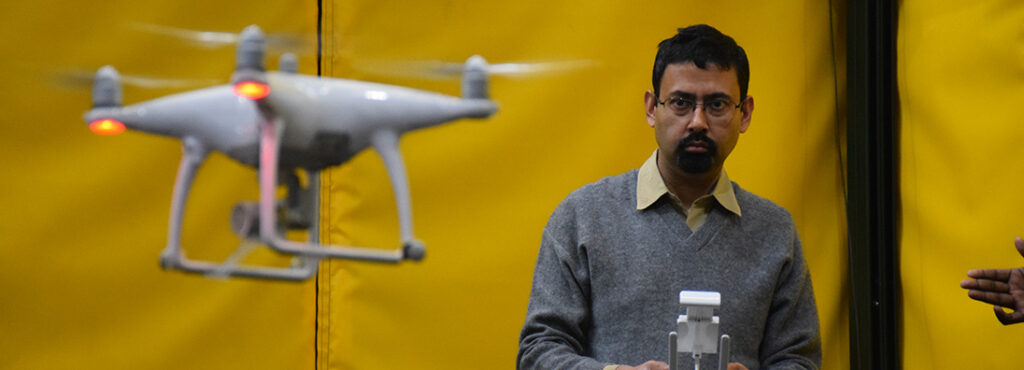
Over the past forty years, wildfires have become more common, more destructive and more difficult to contain. In dry conditions, a spark can turn into a forest fire covering thousands of acres over the course of a few hours. Trying to contain a fast-moving fire is a challenge for firefighters, emergency responders and communities who may have just minutes to evacuate. Fires can travel up to six miles per hours in forests and up to 14 miles an hour in dry grass. If terrain slopes upwards, those speeds can double.
Real time monitoring of fire conditions and movement could help firefighters improve containment strategies but getting data from manned or unmanned aircraft above a raging forest fire has been a challenge.
“This is not just flying in isolation,” says mechanical and aerospace engineering Professor Amit Sanyal. “There is hot air from fires and different air currents being induced. Sensors also have to deal with smoke, ash, burning leaves or leaves about to catch fire.”
Even when an unmanned aerial vehicle (UAV) can be put in the air near a fire, getting data from multiple sensors and input systems back to fire crews on the ground in real time becomes a processing challenge. Especially for a small UAV where load restrictions limit the size and weight of any on-board processing systems.
An interdisciplinary collaboration between Sanyal and two faculty members from The Ohio State University has received a National Science Foundation (NSF) National Robotics Initiative grant to explore the integration of unmanned aerial systems (UAS) into prescribed wildland burn projects. Mechanical and aerospace engineering Professor Mrinal Kumar and forest ecosystem analysis and management Professor Roger Williams from The Ohio State University will be Co-Principal Investigators with Sanyal on the project. Syracuse University will receive $536,983 from the NSF grant to support Sanyal’s research.
Research has shown that climate change has led to warmer, drier conditions in many parts of the world. With reduced snowpack and precipitation, many forests and areas that are already susceptible to wildfires will become even drier. The U.S. Forest Service predicts the percentage of land area determined to be experiencing extreme drought conditions will increase by 30 percent by 2090.
The research team will explore how topographic, atmospheric and forest fuel factors in temperate hardwood forests influence fire intensity and rate of spread through real-time data activation in fire behavior models. Sanyal has extensive research experience with UAV control systems and sees this project as a natural evolution of where his interests have been going.
“A UAV in close proximity to a fire needs dependable and robust control schemes,” says Sanyal. “A non-linear model-free control system has a lot of potential.”
The system Sanyal envisions could allow an UAV to be able to deal with the known physics (elevation, topography) and also rapidly adapt to the unknown physics it might face (sudden and extreme changes in heat, winds or air currents.)
“In order to do that in real time, we need to learn from the data really fast and compensate for it,” said Sanyal. “I think it would be interesting to consider what is known and what is unknown in an ultra-local model of the multi-input, multi-output system that is suitable for implementation on a small onboard processing system.”
The Ohio State University will provide the team with the ability to do controlled burns and test their systems in actual wildland fire conditions. Their work will help provide real time data to firefighters and fire coordinators working to manage hazardous situations and keep people around the world safe.
“Autonomous systems are an area of strength for Syracuse University researchers. This NSF grant demonstrates the potential of cross-disciplinary and multi-institutional research for finding solutions to pressing problems,” says Ramesh Raina, interim vice president for research.
“It is a human problem and a wildlife problem. It would be great if we can make a difference in how we deal with this problem,” says Sanyal.
